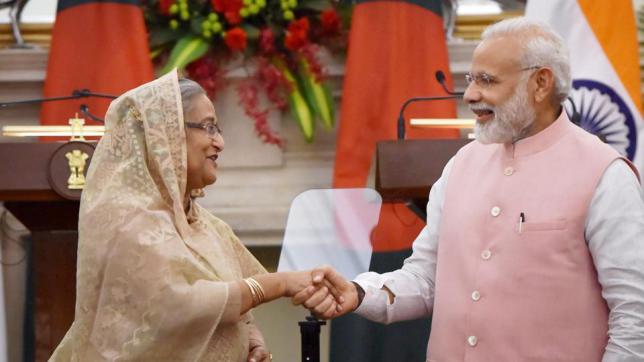Published in The Daily Star on Sunday, 16 April 2017
MACRO MIRROR
INDIA-BANGLADESH ECONOMIC COOPERATION
Walking the talk – Dr Fahmida Khatun
 Bangladesh’s long dynamic relationship with India has many facets, ranging from economic to social to political. Trade, investment, power and energy, communication, education and health are areas where a bilateral relationship exists. During the past few years, there has been a visible attempt to improve this relationship. The recent visit of Bangladesh’s Prime Minister to India during April 7-10, 2017 has brought the relationship between the two countries to a new level. Of course, the achievement has, to a large extent, been overshadowed by the disappointing outcome on the Teesta water sharing issue. As much as it was an outright rejection to a just and authentic demand of Bangladesh, the attitude of the leader of West Bengal towards the issue was equally insensitive. While the West Bengal leader wants to gain political mileage in her constituency, it’s the suffering of Bangladeshis living in the region that has been completely ignored.
Bangladesh’s long dynamic relationship with India has many facets, ranging from economic to social to political. Trade, investment, power and energy, communication, education and health are areas where a bilateral relationship exists. During the past few years, there has been a visible attempt to improve this relationship. The recent visit of Bangladesh’s Prime Minister to India during April 7-10, 2017 has brought the relationship between the two countries to a new level. Of course, the achievement has, to a large extent, been overshadowed by the disappointing outcome on the Teesta water sharing issue. As much as it was an outright rejection to a just and authentic demand of Bangladesh, the attitude of the leader of West Bengal towards the issue was equally insensitive. While the West Bengal leader wants to gain political mileage in her constituency, it’s the suffering of Bangladeshis living in the region that has been completely ignored.
On the economic front, India and Bangladesh have signed 22 agreements in areas such as defence, civil nuclear energy, cyber security, power, skill development and developmental cooperation. Two lines of credit worth USD 5 billion were signed. One of the LoCs worth USD 4.5 billion is for 17 projects in infrastructure and power. The other LoC for USD 500 million is for the purchase of defence hardware. Also, the two countries signed 13 business-to-business pacts, mainly in power and energy valued at about USD 9 billion. Bangladeshi Prime Minister urged the Indian business community to invest in infrastructure projects, power and energy, food and agro-processing, and the manufacturing and transport sector.

The history of LoCs offered by India to Bangladesh dates back to 2010, when the first LoC worth USD 1 billion was signed. Later USD 200 million of LoC-1 was converted into grants which are being used in the construction of the Padma Bridge. LoC-1 was enhanced from USD 800 million to USD 862 million in 2015. A total of 15 projects are to be implemented under the first LoC. India signed a new credit agreement amounting to USD 2 billion to implement socio-economic development projects in Bangladesh in 2016 through LoC-2. The interest rate for LoC-2 was fixed at one percent annually with a 20-year repayment term, including a five-year moratorium. LoC-2 was to fund social and infrastructure development projects in the power, railways, road, transport, information and communication technology, shipping, health and technical education sectors.
LoCs have the potential to contribute to the development of Bangladesh. However, disbursement of LoCs are lengthy and slow. Translating the agreements to project framework takes a long time which impacts the implementation of the projects. The Economic Relations Division has to prepare specific projects against the LoCs which are to be implemented by various ministries. Shortcomings, in case of preparation of project framework and speedy approval of project proposals, should be overcome if the LoCs are to be used efficiently. Conditionalities attached with LoCs, such as spending money for purchasing equipment and raw materials from India, are not favourable. Bangladesh currently has a foreign exchange reserve of USD 32.3 billion, which is quite adequate to undertake our own development projects. We could have survived without another LoC. Of course, cooperation in areas such as space technology, evacuation support at Rooppur, ICT training, establishment of medical colleges etc is well appreciated. Bangladesh also needs support to improve its technical knowhow and human resource capacity. We also need scholarship opportunities so that bright Bangladeshi students can study in Indian education institutes, such as the Indian Institute of Management (IIM) and Indian Institute of Technology (IIT), leading medical colleges, nuclear science institutes and agricultural research centres.
Far more clarity is required in the implementation of investment deals. For example, how Reliance Power Ltd would use USD 1 billion to construct liquefied natural gas-based power plant at Meghnaghat, how can the standard of equipment to be used in power plants be ensured, and what will be the pricing of LNG, are critical issues to be considered. Similarly, Bangladesh needs a LNG policy along with a LNG pricing mechanism. Clarity is also required in regard to coal-fired power plants as well as power tariff. On the other hand, initiatives, such as the establishment of Indian Exim Bank in Bangladesh, are likely to facilitate local Bangladeshi entrepreneurs to set up large projects with Indian origin capital equipment.
It is expected that the agreements signed between the two neighbouring countries will help improve trade and connectivity and ensure security. In the end, it can contribute towards bringing about economic well-being of the population in the region. India wants to reach out to its ‘seven sister states’ through Bangladesh. Also, Bangladesh is crucial for regional security and stability. However, in order to have a more meaningful economic cooperation, a number of unresolved issues need to be settled. Bangladesh’s huge trade deficit with India is one of those.
In FY2016, Bangladesh’s export to India was USD 689.6 million while Bangladesh’s import from India was USD 5,452.9 million. Due to various non-tariff barriers, Bangladesh has been unable to take advantage of duty free access of its products in India’s market. Other trade measures, such as anti-dumping by India on the export of jute from Bangladesh, are also harmful for us.
Full details of the agreements are yet to be made available in the public domain. On the face of it, these deals mostly look promising for both India and Bangladesh. The final outcome, of course, will depend on how they are implemented and how the balancing string is settled between the two countries. Sincerity is expected from both sides, especially India, to ensure that the attainment of ‘public good’ from the projects is kept beyond narrow political interests.
The writer is Executive Director of the Centre for Policy Dialogue.

